A Death by Drowning, an Inquest and the Brisbane Flood of 1890.
Brisbane, a city built along a river, has documented flood events since colonial settlement. John Oxley in his exploratory journey up the Brisbane River in 1824, observed evidence of previous floods, but the Great Flood of February 1893 was considered the most destructive.[1] Three years before that event was the Flood of 1890, which occurred over a period of 3 days from the 11th to 13th March. At the time, a Mr Childs, an old Breakfast Creek and Newstead resident of 42 years, recalled the levels of floods from 1857, 1864 and 1887 and thought this one was the worst.[2] Railway lines and bridges were damaged or washed away, telegraphic communications were broken, homes were inundated by flood water or destroyed, leaving many homeless, and a number of people were drowned.[3]
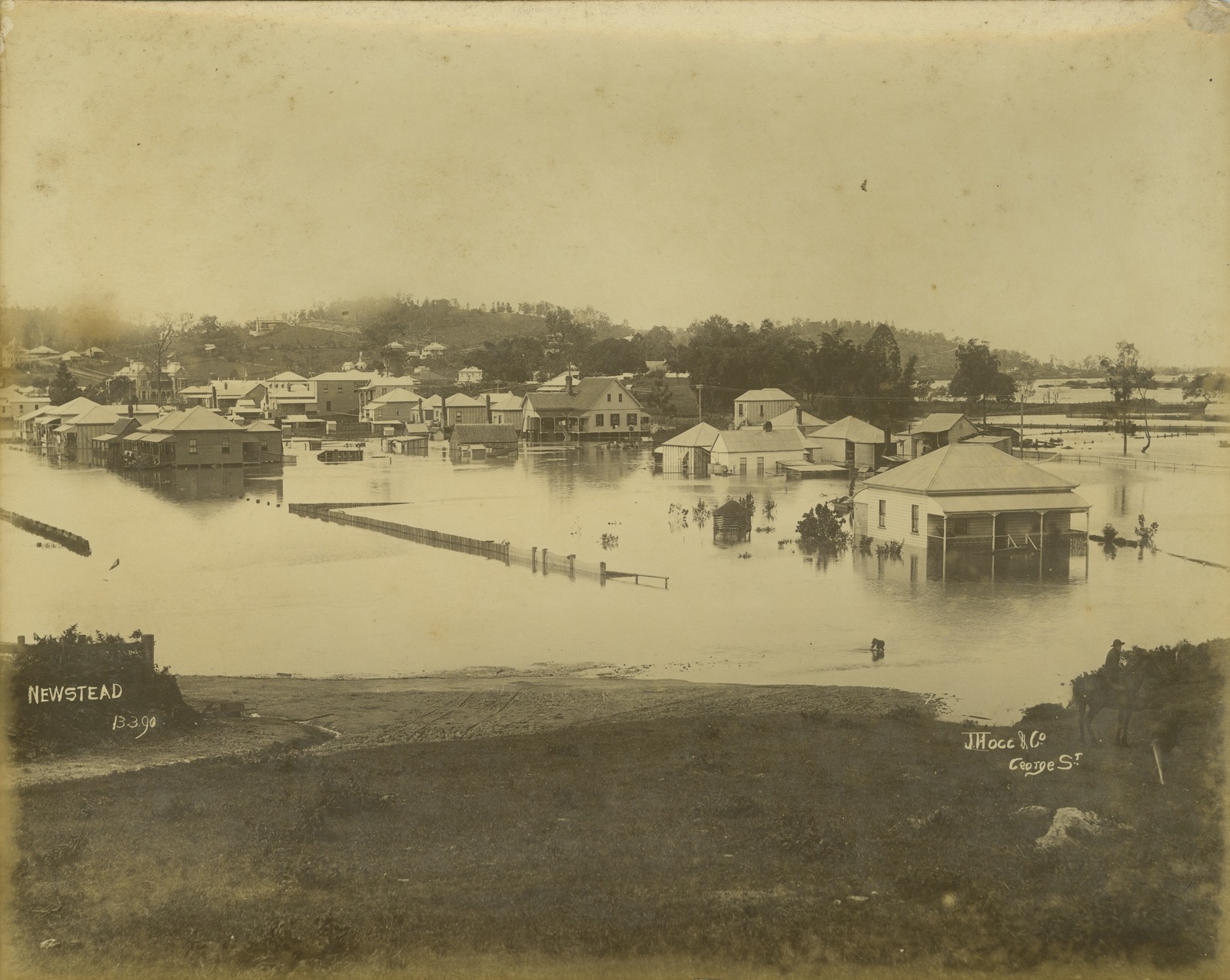
State Library of Queensland. Hogg, J. J. (n.d.). Houses surrounded by floodwaters at Newstead, Brisbane, 1890.
Laurence Evans was one of the lives lost in that flood. The above image taken by John Jackson Hogg appears to be taken nearby on the same day as Laurence drowned. He was the son of George and Bridget Evans of James Street, Fortitude Valley, my great-grandmother’s brother, drowned in the evening of Thursday, 13th.March 1890. Aged 21, he was working with his father as a drayman but in the afternoon of that day he had been drinking with a group of young men at the Queen’s Arm Hotel in James Street, close to the Evan’s family home. Fortitude Valley is located on the north side of the Brisbane River and close to the inner-city suburbs of New Farm, Breakfast Creek and Newstead, then known as Bulimba.[4]
The Maryborough Chronicle portrayed Laurence and his young male friends as “larrikins”:
“Breakfast Creek yesterday. The body of a man named Evans was found yesterday near Waterloo, Fortitude Valley. He was drowned while in a punt with a number of larrikins. The police consider the case suspicious and have ordered a postmortem’.[5]
An inquest held on the 21st, 24th, and 31st of March 1890 at the Police Court, Brisbane by G.P.M. Murray Police Magistrate revealed the circumstances surrounding Laurence Evans death.[6]
The tragedy of the whole situation was that no one had though to tell his parents of what had happened that evening or to check if he had arrived home safely. He did not come home that night and neither did he return the next day. Without the advantage of modern communication, it wasn’t until the 15th before Thomas Marks went looking for his body as there were rumours that Laurence had drowned.
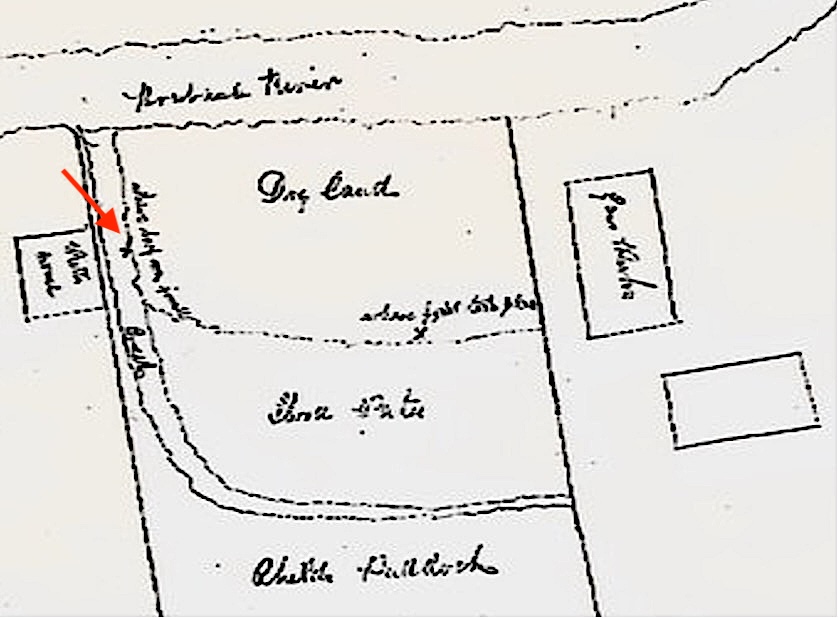
Exhibit 1. Drawn by Constable Seymour showing Brisbane River, X marks where body found on left, Dry land and X where fight started. Flood Water and Childs Paddock, Gas Works on right. Qld State Archives, Inquest. (Red arrow marked for ease of viewing)
Thomas, a boilermaker, explained to the Court how he had gone down the river as far as Child’s Creek, where he found the body on some rocks about twenty yards from the mouth of the creek, not far from the Gasworks. He tied a rope around the neck and towed the corpse face down, back to dry land. He immediately went to the Fortitude Valley Police station and spoke to Constable Thomas Seymour. They both returned to the foot of Evelyn Street near the gasworks at Breakfast Creek, where the body had been secured. William Evans also came and confirmed that the body was his brother, Laurence. A post-mortem was carried out at the morgue by Dr Tilston, who found no marks of violence on the body and concluded that death was caused by drowning.
Constable Seymour’s investigation identified 15 people who were involved in the incident on that evening of the 13th. The first group to take the stand were the young men who were in the boat with Laurence. David Dougall, a blacksmith, Patrick Harten, a bottler, James Moore, a bootmaker, John Donoghue, labourer, William Brown, a drayman, the youngest and the only one who had not been drinking. He told the inquiry that the older men came running after them with sticks, fence palings and paddles, driving them back into the water. Blows were exchanged and people were injured. Evans came ashore with a boot in his hand.
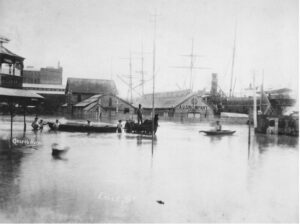
Queens Hotel to left with A.U.S..N Co building near the wharf on right. Eagle Street Brisbane in flood, 1890. State Library of Queensland neg: 91407 B&W March 1890 creator Hogg, John Jackson.
According to David Dougall, when the men approached them wanting to fight, some of them ran away in different directions and thought that Evans had run away. He did admit to chasing ducks but said he did not kill any. There were different stories about what happened to Laurence. No one saw him after the altercation but in the confusion, none of his mates were sober enough to realize that he had drowned and because they could not find him they though he had gone home.
From the evidence given, most of the group had spent at least an hour at the Queens Arms Hotel drinking, including Evans. John Donoghue had visited several other hotels that day. At about 6pm they all went in a large rowboat to take one of their companions, named Brennan to work at the Brisbane Gas Company. There were 10 in the boat, although not all gave evidence at the inquiry.
The men in the other boat gave their side of the story. They were Thomas Morris, Charles Hardrath, George Berry, William Dickson, James Ellis and William McLaughlin. None of the older men had been drinking but they had seen and heard the young men coming from Fortitude Valley and thought they were coming to catch and kill the ducks, which they claimed were theirs.
Henry Runnagar, a fireman, who was working at the Gasworks that night, watched the fight between the two groups. He said the young men were “tipsy” and saw them fall into the water on top of one another as they chased ducks that were gathered on the only dry patch of land, but didn’t see them kill any of the ducks, as others claimed. He could hear the men in the second boat calling out that the ducks belonged to them and believing that the young men had killed two ducks.
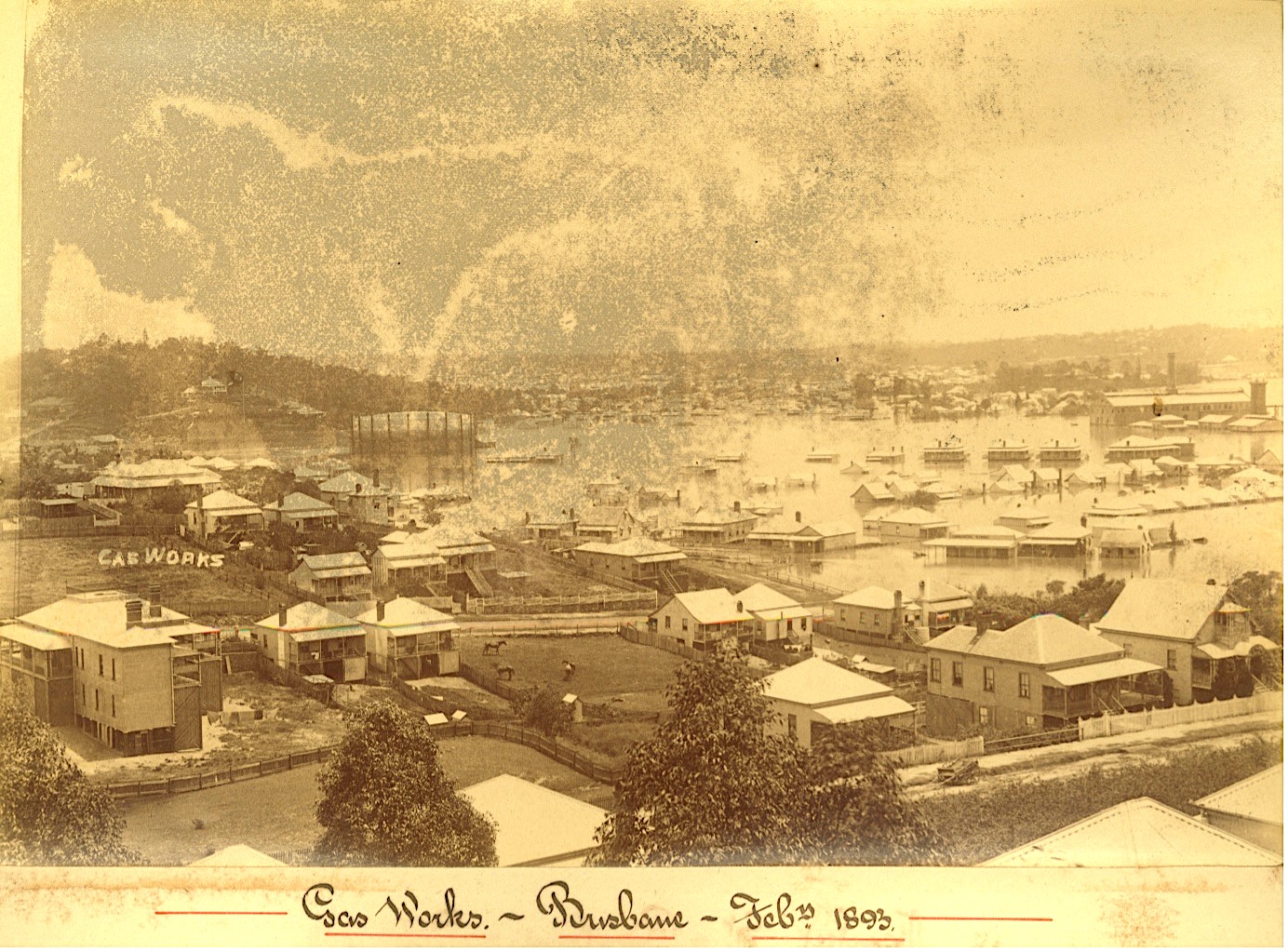
Gas works, Brisbane, during the February 1893 flood. Large building front left is 291 Harcourt Street, Teneriffe and Newstead Gasometer in middle of photograph. https://collections.slq.qld.gov.au/viewer/IE1414687
The concluding comment from the Magistrate found that “The death of this man appears to have been the result of a row between two parties during the late flood. It seems that immediately after the fight in which the deceased was engaged, he was missed by his companions some of whom said he had gone home. It is in evidence that the deceased with others was chased into the water by Ellis, Berry and McLaughlin”.[7] & [8]
The death certificate, issued in Brisbane, Colony of Queensland, records drowning as cause of death and is certified by Geo P. M.Murray, P.M. Magistrate who held the Inquiry.[9]
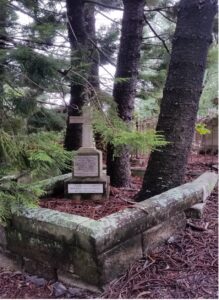
Laurence Evans Grave and headstone, Toowong Cemetery. Photo taken by author 2017.
Unlike the great flood of 1893, the Gasworks was not completely inundated by flood waters in 1890. The ovens that baked the coal, sat above the flood waters and its workers were still able to work and stoke the fires.[10]
The flooding of 1890 followed by the floods of 1893 “occurred in a time of economic depression” but by the late 1890’s the economy begins to recover.[11]
When I first started my family history journey, I had been told by my aunt, Sr Zita, that there was a grave at the Toowong Cemetery in which were buried 7 babies. I later found the grave in the Irish Section, overgrown and damaged by large cypress pines. There were babies buried in the grave, but only 3. The plaque reads “Of your charity pray for the soul of Laurence Evans. Who departed this life March 14th, 1890. Aged 21 years.” He was buried at Toowong Cemetery on the 16 March 1890, John Cannon was the Undertaker.[12]
[1] https://www.slq.qld.gov.au/blog/overview-brisbane-river-floods
[2] “The Floods.” The Brisbane Courier (Qld. : 1864 – 1933) 14 March 1890: 5. Web. 3 Feb 2025 http://nla.gov.au/nla.news-article3515486
[3] ibid
[4] Lambert, John Terance, A Commemoration of the Closure of the Newstead Gas Plant, 6 September, Boral Energy, Milton, 1996, p32
[5] “Brisbane.” Maryborough Chronicle, Wide Bay and Burnett Advertiser (Qld. : 1860 – 1947) 17 March 1890: 2. Web. 3 Feb 2025 http://nla.gov.au/nla.news-article146750451.
[6] Qld State Archives File No: 114 QSA Ref: JUS/N174. Prev Item ID: ITM348773. Item ID: PR2730288. Series ID: S36
[7] Qld State Archives File No: 114 QSA Ref: JUS/N174. Prev Item ID: ITM348773. Item ID: PR2730288. Series ID: S36 (dated 21, 24 & 31 March 1890)
[8] ibid (aka William McLaughlin mentioned in the full document)
[9] Queensland Historical Death Image, Ref No.1890/B/22907. Date of Death, 13 Mar 1890.
[10] Lambert, John Terance, A Commemoration of the Closure of the Newstead Gas Plant, 6 September, Boral Energy, Milton, 1996, p32.
[11] Ibid, p42.
[12] Queensland Historical Death Image, Ref No.1890/B/22907. Date of Death, 13 Mar 1890.

Catherine I didn’t realise you had Evans in your family my grandmother second marriage was an Evans.